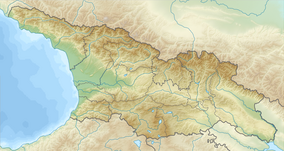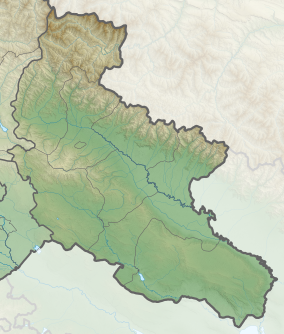This article needs additional citations for verification. (November 2018) |
Vashlovani Strict Nature Reserve (Georgian: ვაშლოვანის სახელმწიფო ნაკრძალი) is a protected area in Dedoplistsqaro Municipality, Kakheti region of Georgia on Shiraqi mountain range and Georgian bank of Alazani River,[1] at elevation 300-600 meters above sea level.[2]
| Vashlovani Strict Nature Reserve | |
|---|---|
 Vashlovani at Georgia and Azerbaijan border. | |
| Location | |
| Coordinates | 41°09′17.5″N 46°32′49.6″E / 41.154861°N 46.547111°E |
| Area | 176.12 km2 (68.00 sq mi)[1] |
| Established | 1935 |
| Governing body | Agency of Protected Areas |
| Website | Vashlovani Protected Areas Administration |
The total protected area is 10,143 hectares, with forest at 4.032 ha, and the rest are fields, desert, ravines. The purpose of the Nature Reserve is to protect and preserve rare species of rare forest flora and fauna.
Flora
editProtected forest mostly has pine tree and juniper. There are also Celtis, Pyrus salicifolia, pomegranate, Prunus mahaleb, Spiraea, Paliurus and wild pistachio tree (Pistacia mutica).[3]
Fauna
editThere are many species of birds: Rock partridge, Griffon vulture, Eurasian golden oriole, Mistle thrush, including near threatened Cinereous vultures (Aegypius monachus).[4] Mammals are represented by wild boar, rabbit, fox, wolf, bear, striped hyena, European badger and leopard (Panthera pardus).[5]
Climate
editIn terms of climate this is the most dry and harsh region in Georgia. Climate is characterized by dryness and heat.
See also
editReferences
edit- ^ a b "Vashlovani in Georgia". Protected Planet. Retrieved 2018-11-02.
- ^ Vashlovani Protected Areas Administration Agency of Protected Areas
- ^ George Nakhutsrishvili The Vegetation of Semi-Deserts, Steppes and Arid Open Woodlands. ISBN 978-3-642-29914-8 ISBN 978-3-642-29915-5 DOI https://doi.org/10.1007/978-3-642-29915-5_5 Springer-Verlag Berlin Heidelberg 2013
- ^ Alexander Gavashelishvili, Mike J. McGrady, Zura Javakhishvili Planning the conservation of the breeding population of cinereous vultures Aegypius monachus in the Republic of Georgia Oryx Volume 40, Issue 1 January 2006 , pp. 76-83 https://doi.org/10.1017/S0030605306000081
- ^ I.G. Khorozyan, A.V. Abramov The Leopard, Panthera pardus, (Carnivora: Felidae) and its resilience to human pressure in the Caucasus. Zoology in the Middle East, Volume 41, Issue 1 Pages 11-24 2007. Taylor & Francis https://doi.org/10.1080/09397140.2007.10638222

